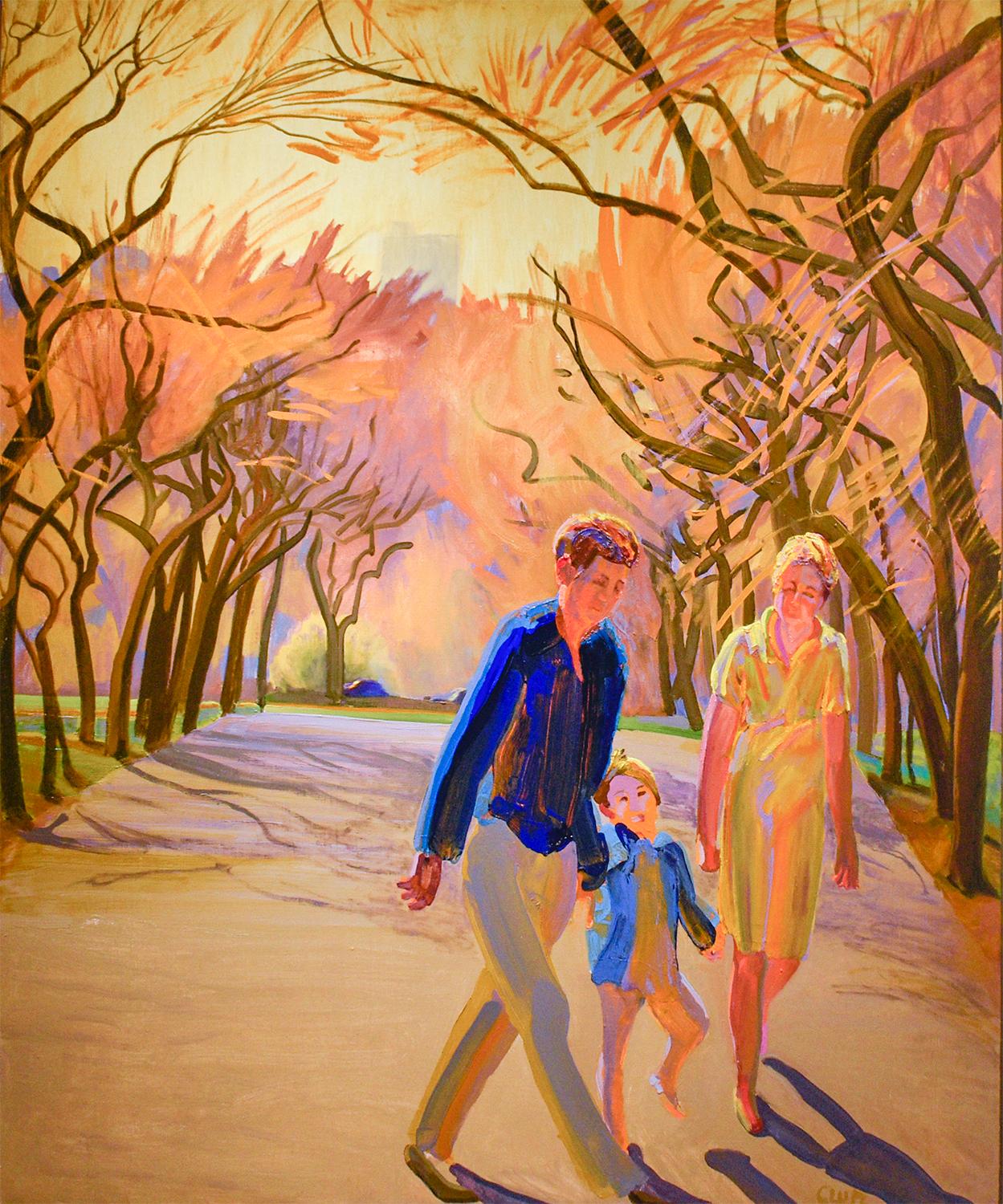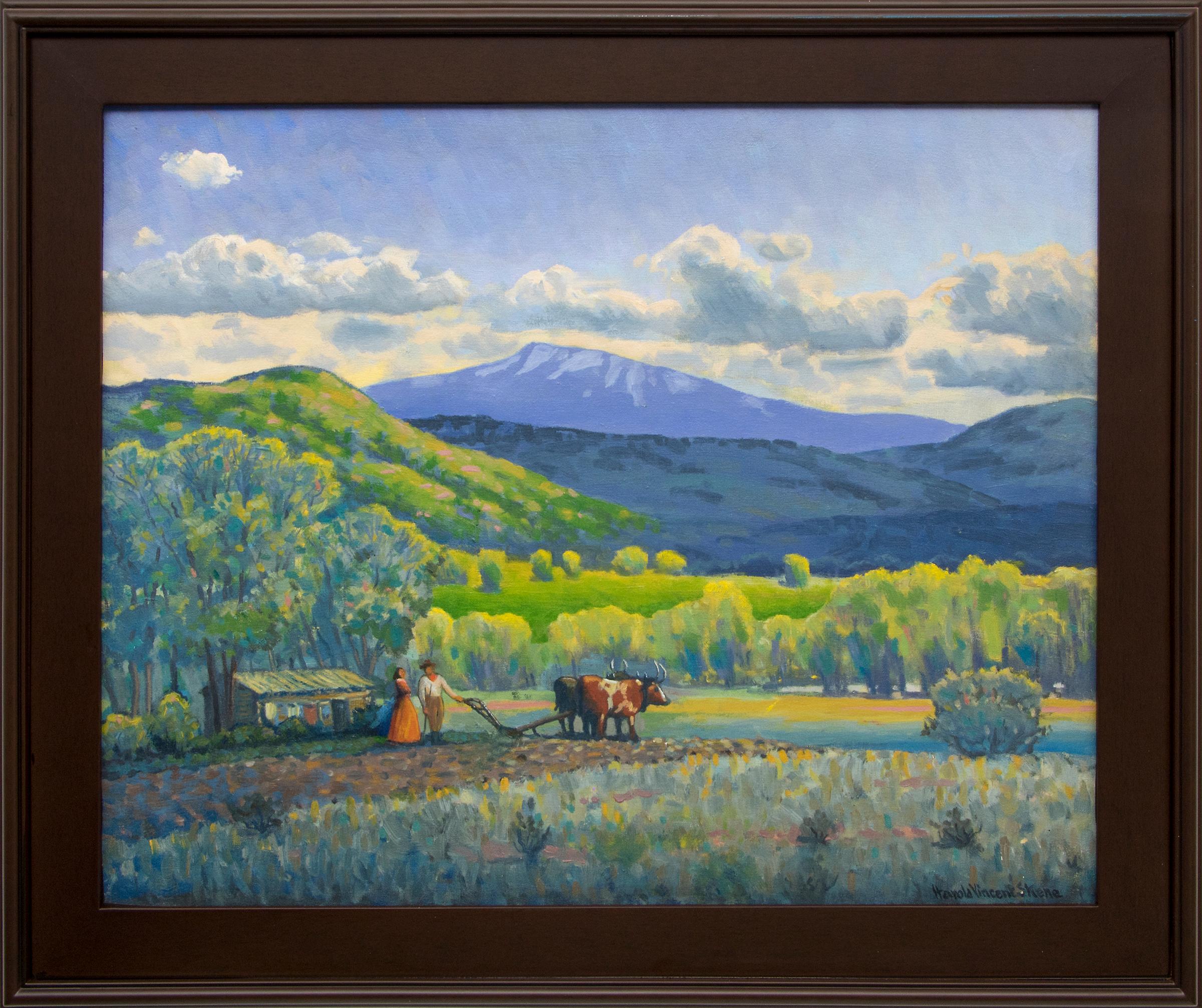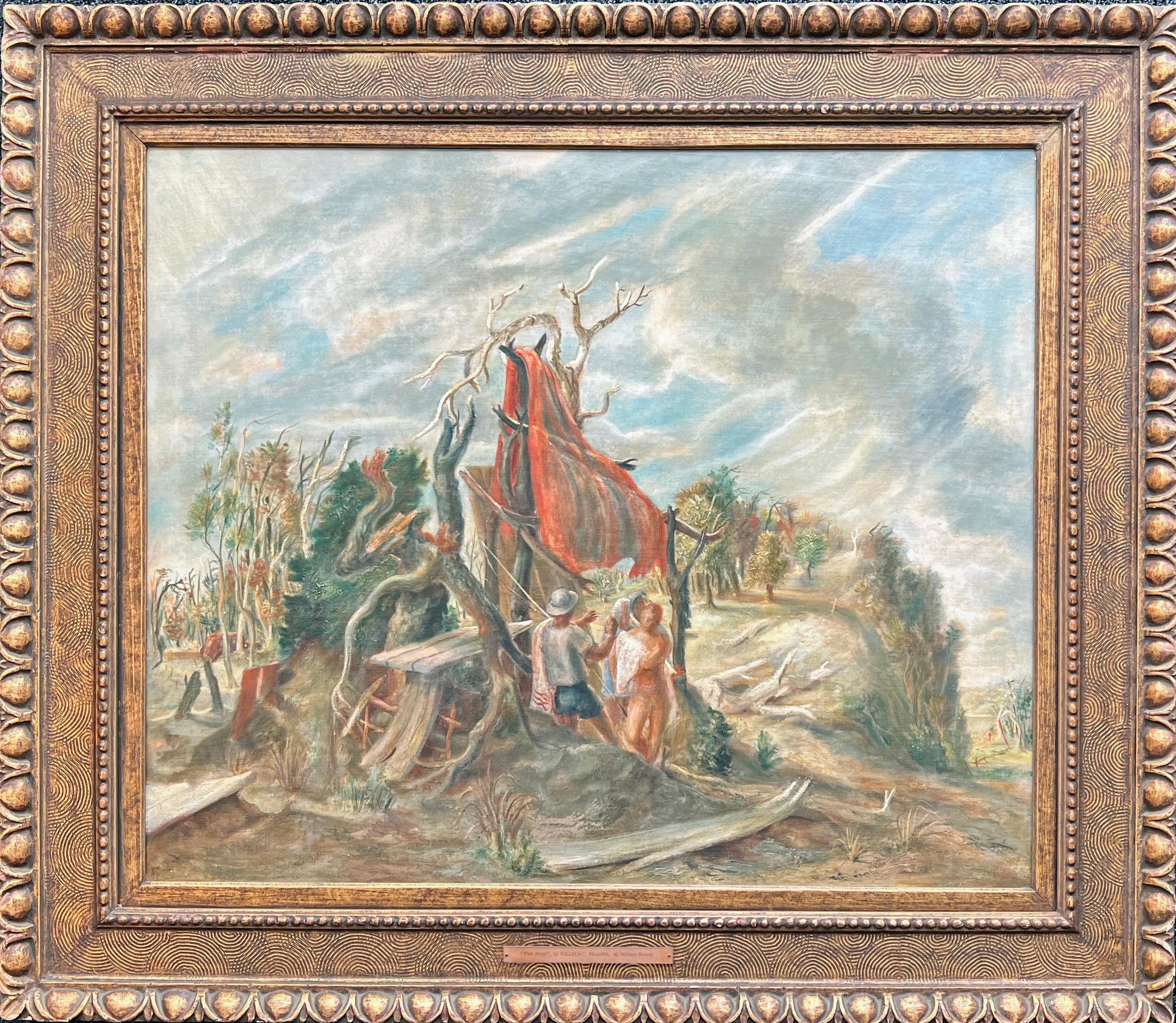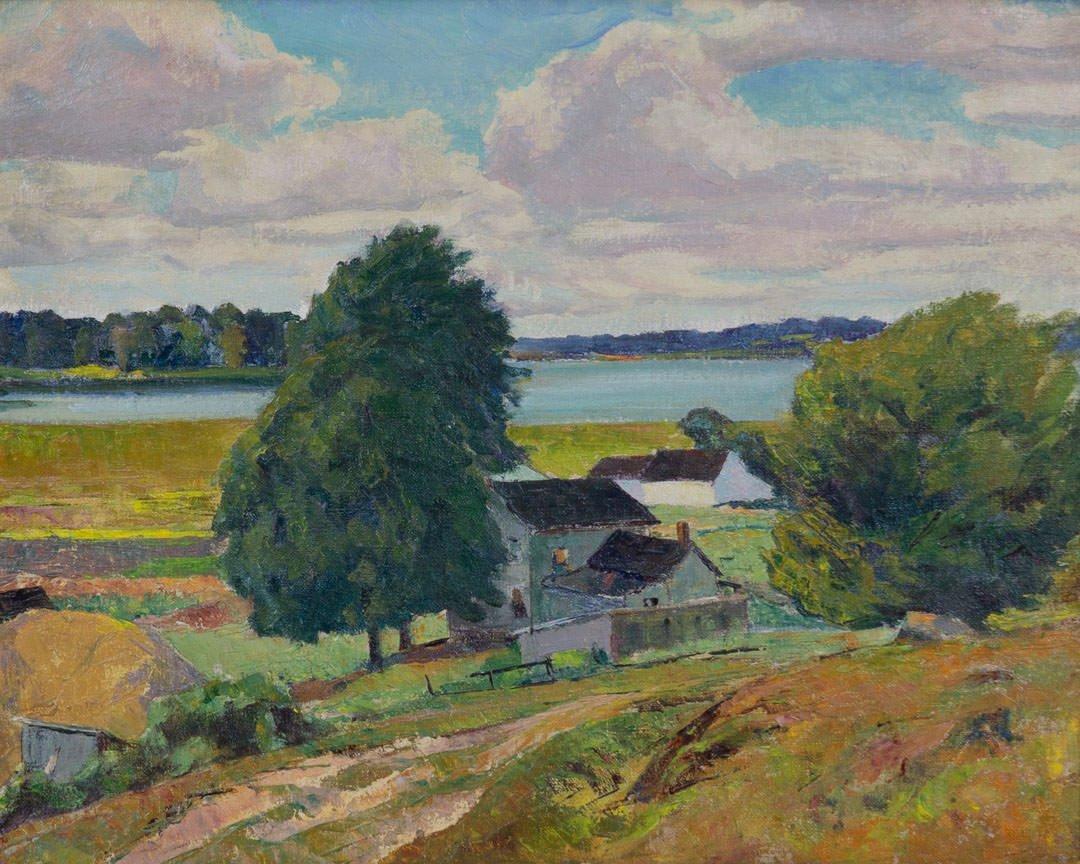Items Similar to WATTS TOWER
Want more images or videos?
Request additional images or videos from the seller
1 of 15
Gloria StuartWATTS TOWER1971
1971
About the Item
GLORIA STUART (1910 – 2010)
WATTS TOWERS, 1971
Oil on canvas, signed lower right, 24” x 50 ½”. Gloria Stuart, an Academy Award nominated actress was also a painter, illustrator and printmaker. She most recently portrayed Rose in the blockbuster film “Titanic”. She was a Santa Monica native.
In 2013 The Los Angeles Museum of Art, LACMA exhibited a nearly identical painting looking from the south, the same size and frame. Last 5 photos show the example at LACMA. One shows theirs in a distant room with a major Thomas Hart Benton painting in the foreground
A VERY IMPORTANT MULTI-LEVELED DOCUMENT OF LOS ANGELES AND HOLLYWOOD CULTURAL HSTORYi
The following is from her obituary in the Los Angeles Times upon her death in September 2010 at the age of 100
Gloria Stuart, a 1930s Hollywood leading lady who earned an Academy Award nomination for her first significant role in nearly 60 years — as Old Rose, the centenarian survivor of the Titanic in James Cameron’s 1997 Oscar-winning film — has died. She was 100.
.......She devoted much of her time to designing and printing artists’ books (handmade, letter-press printed books in limited editions, with her own artwork and writing). Her work is in the J. Paul Getty Museum in Los Angeles, the Metropolitan Museum of Art in New York City, the Victoria and Albert Museum in London and other museums.
Stuart, a founding member of the Screen Actors Guild who later became an accomplished painter and fine printer, died Sunday night at her West Los Angeles home, said her daughter, writer Sylvia Thompson.
Stuart had been diagnosed with lung cancer five years ago.
“She also was a breast cancer survivor,” Thompson said, “but she just paid no attention to illness. She was a very strong woman and had other fish to fry.”
In July the actress was honored at an “Academy Centennial Celebration With Gloria Stuart” at the Samuel Goldwyn Theater in Beverly Hills.
“She was a charming and beautiful leading lady in the ‘30s, and I never understood why her career didn’t go further at that time,” film historian and critic Leonard Maltin, who interviewed Stuart on stage at the event, told The Times on Monday.
As for Stuart’s high-profile comeback in “Titanic”: “She was thrilled by the attention that that performance brought her and really wanted to win that Oscar. I thought she hit just the right notes in that performance. She was wry and engaging.”
As a glamorous blond actress under contract to Universal Studios and 20th Century Fox in the 1930s, Stuart appeared opposite Claude Rains in James Whale’s “The Invisible Man” and with Warner Baxter in John Ford’s “The Prisoner of Shark Island.”
She also appeared with Eddie Cantor in “Roman Scandals,” with Dick Powell in Busby Berkeley’s “Gold Diggers of 1935” and with James Cagney in “Here Comes the Navy.” And she played romantic leads in two Shirley Temple movies, “Poor Little Rich Girl” and “Rebecca of Sunnybrook Farm.”
But mostly she played what Stuart later dismissed as “stupid parts with nothing to do” — “girl reporter, girl detective, girl nurse” — and “it became increasingly evident to me I wasn’t going to get to be a big star like Katharine Hepburn and Loretta Young.”
After making 42 feature films between 1932 and 1939, Stuart’s latest studio contract, with 20th Century Fox, was not renewed. She appeared in only four films in the 1940s and retired from the screen in 1946.
By 1974, “the blond lovely of the talkies” had become an entry in one of Richard Lamparski’s “Whatever Happened to” books.
Writer-director Cameron’s $200-million “Titanic” changed that.
Stuart played Rose Calvert, the 100-year-old Titanic survivor who shows up after modern-day treasure hunters searching through the wreckage of the sunken ship find a charcoal drawing of her wearing a priceless blue diamond necklace.
Stuart’s performance as Old Rose frames the 1997 romantic- drama that starred Leonardo DiCaprio as lower-class artist Jack Dawson and Kate Winslet as the upper-class young Rose.
In “Gloria Stuart: I Just Kept Hoping,” her 1999 autobiography, Stuart said that after reading the script, “I knew the role I had wanted and waited for all these many years had arrived! I could taste the role of Old Rose!”
Cameron told The Times in a 1997 interview that he chose Stuart because he was “looking for a pro from the ‘30s or ‘40s, someone probably retired, maybe off the Hollywood radar for awhile.”
“I had to have someone who’d play the latter part of the life of someone we’d recognize, Kate Winslet, so it couldn’t be someone like Katharine Hepburn. We know so well what she looked like [when she was young],” Cameron said. “Gloria had just enough distance, and she gave this fantastic reading.”
At 87, Stuart became the oldest actress ever nominated for an Academy Award.
In addition to Oscar and Golden Globe nominations, she won a Screen Actors Guild award for outstanding performance by a female actor in a supporting role (tying with eventual Oscar-winner Kim Basinger for “L.A. Confidential”).
In the multiple-Oscar-winning blockbuster’s wake, Stuart found herself swamped with fan mail and interview requests. She also was faced with being recognized in the supermarket and finding her old films resurfacing on television. People magazine even named her one of the 50 most beautiful people in the world.
In 2000, several hundred fans gathered on Hollywood Boulevard next to the Egyptian Theater for the unveiling of Stuart’s star on the Hollywood Walk of Fame.
“I cannot begin to tell you how rewarding and nourishing and warming it is,” she said at the ceremony. “I wake up every day and say, ‘What a wonderful life. How lucky I am.’ ”
A third-generation Californian, she was born Gloria Stewart in Santa Monica on the Fourth of July, 1910. She later changed the spelling of her last name to Stuart, reasoning that the six letters would balance perfectly on a theater marquee with the six letters in “Gloria.”
In high school, she took classes in short-story and poetry-writing and worked for free as a “girl reporter” at the Santa Monica Outlook.
While attending UC Berkeley, where she acted in a campus theatrical group, Stuart met a handsome young sculptor, Gordon Newell. They were married in 1930 and moved to Carmel, where she worked on the local newspaper and appeared in little theater productions.
In 1932, after playing Masha in a little theater production of Chekhov’s “The Seagull” in Carmel, the visiting director asked her to play the role again in a small theater in the Los Angeles area.
Casting directors from both Paramount and Universal saw her performance and offered her screen tests. She wound up signing a seven-year contract with Universal: $125 a week to start, with singing and acting lessons included.
Stuart’s union activities began while making Whale’s 1932 horror comedy “The Old Dark House” with Boris Karloff and Melvyn Douglas.
“All of us were just exhausted by the long hours, and Melvyn Douglas leaned over to me in this theatrical way,” she recalled in a 1998 Los Angeles Times interview. “He whispered the word ‘union’ in my ear. And I thought, ‘Yes!’ ”
At the time, she wrote in her autobiography, “Actors worked unconscionable hours — especially females, because every morning our needs included a great deal of time in hairdressing and makeup. Meals were served at the convenience of the production staff. There was no allotment for travel time, no standard hours between work calls, no pay for overtime or double overtime — what we call golden time. And if an actor under contract refused a role the studio had chosen, he/she was suspended without pay — and the time was added on to the contract!”
Despite stiff studio resistance, the Screen Actors Guild was founded in 1933.
Discovering that she “took to politics like a duck to water,” Stuart helped form the Hollywood Anti-Nazi League in 1936, the same year she and writer Dorothy Parker helped organize the League to Support the Spanish War Orphans. She also became a member of the Hollywood Democratic Committee and was on the executive board of the California State Democratic Committee.
Stuart’s fledgling movie career took a toll on her marriage to Newell and they divorced. In 1934, she married screenwriter Arthur Sheekman, with whom she had her daughter Sylvia.
Stuart, whose career at Universal failed to take off, signed with 20th Century Fox in 1935.
After Fox declined to renew her contract in 1939, she acted in summer theater on the East Coast and made a failed attempt at Broadway before returning to Hollywood and turning her creative energies into the art of decoupage. She opened a shop on La Cienega Boulevard called Décor Ltd., which lasted more than four years.
In 1954, inspired by an exhibition of Impressionist paintings in Paris, she began painting. Her first one-woman show, at the Hammer Galleries in New York in 1961, was a critical hit. Art News called her “a deft primitive with a beguiling variety of subjects.” She went on to have exhibits in major galleries.
In 1975, four years after her husband was stricken with Alzheimer’s disease, Stuart decided to return to acting. From 1975 to 1988, she had about a dozen minor roles on TV and in movies, including dancing with Peter O’Toole in a nightclub scene in the 1982 film “My Favorite Year.”
As her husband became ill, Stuart began taking classes in bonsai. She became an honored member of local bonsai clubs, and her trees are in the bonsai collection at the Huntington Library, Art Collections and Botanical Gardens in San Marino.
Five years after Sheekman’s death in 1978, Stuart renewed a friendship with an old friend from her college years: Ward Ritchie, who had become a world-renowned master printer. The friendship quickly grew into an autumn romance. From Ritchie, Stuart developed an interest in fine letter-press printing and bought her own hand press.
She devoted much of her time to designing and printing artists’ books (handmade, letter-press printed books in limited editions, with her own artwork and writing). Her work is in the J. Paul Getty Museum in Los Angeles, the Metropolitan Museum of Art in New York City, the Victoria and Albert Museum in London and other museums.
About four months after Ritchie’s death in 1996 at 91, Stuart received a call from James Cameron’s casting director, Mali Finn.
“The next day, Jim came with a video camera,” Stuart told The Times in 1997. “I read for him for about an hour, then I didn’t hear anything, so I wrote him a letter and said, ‘I’ve re-read the script and I should’ve given it a feistier reading.’ I mailed it on Friday and Monday Mali Finn called and said, ‘How would you like to be Old Rose?’ I screamed and hollered.”
Besides her daughter, Stuart is survived by four grandchildren and 12 great-grandchildren.
A private funeral service will be held.
- Creator:Gloria Stuart (1910-2010, American)
- Creation Year:1971
- Dimensions:Height: 24 in (60.96 cm)Width: 45 in (114.3 cm)
- Medium:
- Movement & Style:
- Period:
- Condition:
- Gallery Location:Santa Monica, CA
- Reference Number:1stDibs: LU411312217662
About the Seller
5.0
Recognized Seller
These prestigious sellers are industry leaders and represent the highest echelon for item quality and design.
Platinum Seller
These expertly vetted sellers are 1stDibs' most experienced sellers and are rated highest by our customers.
Established in 1977
1stDibs seller since 2016
266 sales on 1stDibs
Typical response time: <1 hour
Associations
International Fine Print Dealers Association
- ShippingRetrieving quote...Ships From: Santa Monica, CA
- Return PolicyA return for this item may be initiated within 7 days of delivery.
More From This SellerView All
- SURREALIST LANDSCAPEBy Edward HagedornLocated in Santa Monica, CAEDWARD HAGEDORN (AMERICAN 1902 – 1982) SURREAL LANDSCAPE 1931 mixed media on paper, Graphite, ink and watercolor. Unsigned. Dtaed 2/26/31, in ink lower left margin. Image 13 3/4 x 16 1/2 inches. On a large sheet 20 x 25 inches. Provenance: Hagedorn estate, Around the mid 1980's The Hagedorn estate was dispersed in Berkeley by a local dealer. This drawing was part of a group of Hagedorn works on paper that I acquired from that dispersal. Much of the balance was later acquired the Struart Denenberg Fine Art. Denenberg published a very fine book on the artist's work. EDWARD HAGEDORN: CALIFORNIA MODERNIST, RESTLESSNESS AND RESTRAINT Hardcover – January 1, 2009 Subsequently Hagedorn's works on paper have been acquired by many museums and some accompanying exhibitions. ALL OF THE COMMENTS BELOW ARE FROM THE FOLLOWING EXHIBITION EDWARD HAGEDORN (1902-1982) American Modernist A New Traveling Exhibition “VOLCANOS, WRECKS, RIOTS, & NUDES”, EDWARD HAGEDORN (1902-1982) premiere at the Danforth Museum. Framingham, MA, in March 2016. The exhibition includes 75 works of art in various mediums and is accompanied by the first monograph devoted to the artist’s work with essays by leading curators, critics, and art historians. Edward Hagedorn was a true Modernist who created a trove of powerful works on paper--drawings, watercolors, oils, and original graphics that reveal the hand of a master draftsman and the mind of an astute political observer. He rejected the general trend in early 20th century California of local landscapes and coastal views, becoming virtually the single voice of Expressionism. He conveyed the darkness and upheaval that gripped the country in the depression years between the two World Wars, 1925- 1935, more forcefully than any of his contemporaries, influenced by German art of the time, engaging in modernist styles of Expressionism and Surrealism. Hagedorn’s skeletons are ferocious yet somehow endearing; printed in deep black ink on off-white paper, they march across Lilliputian landscapes of grim disorder and destruction. Comets and volcanoes explode in fauvist colors, their other-worldly fluorescent temperas framed in black, while nude female figures, executed in exquisitely refined pen and ink, or graphite line drawings, are as economical in their means as Matisse, and can be compared with the neo-classical drawings of Picasso. Among his most lyrical works of the 1920s is a series of rhythmically abstracted watercolor and ink views of Golden Gate Park, evoking the sensual demi-geometries of Balthus, Derain , and early Mondrian. American Modernist Edward Hagedorn (1902-1982) was born in San Francisco of German descent; his mother (née Kafka) died in childbirth, and he was legally adopted and raised by his grandmother and aunt. After attendance at the San Francisco School of Fine Arts in the early 1920s, by age 22 he had a studio in the famed "100" block of Montgomery Street ("the Monkey Block,") then a haven for bohemians. In 1926, a year of tremendous importance in California artists' embrace of modern art, the Oakland Art Gallery, with the guidance and inspiration of their European representative Emmy (Galka) Scheyer, was the first museum in the United States to show the art of the "Blue Four," among the leading artists of International Modernism--Paul Klee, Lyonel Feininger, Alexei Jawlensky...Category
1930s American Modern Mixed Media
MaterialsWatercolor
- PLOUGHING IT UNDERBy Thomas Hart BentonLocated in Santa Monica, CATHOMAS HART BENTON (1889-1975) PLOUGHING IT UNDER (aka Ploughing) 1934 (Fath 8) Original lithograph, signed in pencil. Edition of 250 as published by Associated American Artists (AA...Category
1930s American Modern Landscape Prints
MaterialsLithograph
- LOTUS FLOWER - ROEDING PARK - Provincetown StyleBy Mary TravisLocated in Santa Monica, CAMARY TRAVIS (Active 1935 - 40) LOTUS FLOWER ROEDING PARK. c.1935-40 White line color woodcut. Signed and titled in pencil. Small edition. 10” x 8”. Full sheet. tears in upper margin. Travis worked in Berkeley, California and was probably a follower of William S...Category
1930s American Modern Landscape Prints
MaterialsWoodcut
- LOTUS FLOWER - Provincetown StyleBy Mary TravisLocated in Santa Monica, CAMARY TRAVIS (1893-1976)) LOTUS FLOWER c. 1935-40 White line color woodcut. Signed and titled in pencil. Small edition. 9 ¾” x 7 7/8”. Full sheet. Some creasing in the margins. Travis worked in Berkeley, California and was probably a follower of William S...Category
1940s American Modern Landscape Prints
MaterialsWoodcut
- THE THAWBy William Seltzer RiceLocated in Santa Monica, CAWILLIAM SELTZER RICE (1873 - 1963) THE THAW c 1915-20 Color woodcut, signed and titled in pencil. Image 8 7/8 x 12 inches, sheet 10 3/4 x 14 3/8 inches. On textured fibrous paper. V...Category
1910s American Modern Landscape Prints
MaterialsColor, Woodcut
- THE RUG WEAVERBy Gustave BaumannLocated in Santa Monica, CAGUSTAVE BAUMANN (1881 – 1971) THE RUG WEAVER, 1910 (Chamberlain 26) Color woodcut signed in pencil. Unnumbed from an edition 100 as published in the Hills o’ Brown...Category
1910s American Modern Figurative Prints
MaterialsWoodcut
You May Also Like
- Bathers at the Quarry 1940s American Modernist Oil Painting WPA eraBy Theresa Berney LoewLocated in Surfside, FLSwimmers and sun tanners at the local watering hole. Her birth name was Theresa Berney. At the time of her passing she was known as Theresa Loew. Birth place: Baltimore artist, blo...Category
1940s American Modern Landscape Paintings
MaterialsOil, Board
- Park Spring (Impressionistic Figurative Painting of Figures in a Park Landscape)By William ClutzLocated in Hudson, NYModern impressionist style figurative painting of a family in a colorful park landscape “Park Spring” painted by William Clutz in 1996 60 x 50 inches in a natural wood floater frame Wire backing, signed lower right This figurative oil on canvas painting was made in 1996 by William Clutz as part of a series of works called "Crossings". These paintings were a study of NYC dwellers engaging in the simple, daily activity of crossing the street. In this piece, Clutz captures a joyful moment of a mother and father walking in a sunlit park landscape with their young child. Bright sunlight radiates through lush fall foliage and fills the scene with a soft orange light. With broad, expressionistic brushstrokes, he discovers the extraordinary in the ordinary, by emphasizing the effects of sunlight on the human form. The painting is in excellent condition and is framed in a natural wood floater frame. More about the artist: In New York in the early 50's and 60's, abstract expressionism was the orthodox approach to art at the time. However, Clutz was committed to his personal style that focused on abstracted human figures within urban tableaux. Working in a context of artists who challenged abstract expressionism's popularity in New York, Clutz established himself as a significant proponent of abstract figuration. His paintings focus on human figures within the urban environment, often exposing the transfiguration of his subjects as they travel through the complex light of city streets or summer parks, as shown in two of his early works. Clutz's interest in working from direct observation of urban life was influenced by a long-standing interest in German Expressionism, as well as artists like Henri Matisse, Arshile Gorky, and Nicholas De Stael...Category
1990s American Modern Figurative Paintings
MaterialsOil, Linen
- Native American Figures at Taos Pueblo, New Mexico Southwestern Oil PaintingLocated in Denver, COOriginal 20th century oil painting by Wolfgang Pogzeba (1936-1982) with Native American figures standing in bright blankets with adobe buildings in th...Category
Mid-20th Century American Modern Figurative Paintings
MaterialsOil, Canvas
- Homesteaders, 1960s Framed Colorado Mountain Landscape Oil PaintingBy Harold Vincent SkeneLocated in Denver, CO"Homesteaders" is an original oil on board painting by artist Harold Vincent Skene (1883-1978) painted in 1960. The painting depicts two figures plowing a field with a pair of oxen, ...Category
1960s American Modern Landscape Paintings
MaterialsOil, Board
- Fish Story oil painting by Williams Charles PalmerLocated in Hudson, NYThis painting is illustrated in the Catalogue of the 1945 Encyclopedia Britannica Collection of Contemporary American Painting, p.84. Written and edited by Grace Pagano. "Painting ...Category
Mid-20th Century American Modern Figurative Paintings
MaterialsOil, Canvas
- Ohio Countryside, 20th century farm landscape, Cleveland School ArtistBy George AdomeitLocated in Beachwood, OHGeorge Gustav Adomeit (American, 1879-1967) Ohio Countryside Oil on artist's board 16 x 20 inches 21.5 x 25.5 inches, framed A major painter of American scene subjects, George Adome...Category
20th Century American Modern Figurative Paintings
MaterialsOil
Recently Viewed
View AllMore Ways To Browse
Watters And Watters
Vintage Tower
Vintage Towers
Tower London
Tower Of London
By Watts Art
Dior 1971
Blue Tower
American Female Landscape Paintings
New York City Towers
Native American War Art
Water Tower
Used Water Towers
Water Tower Art
Vintage Camera Paintings
Video Camera
American Primitive Gallery
Native American Story





